Chapter 11
Using Fields and Tables
Adding text to a set of drawings can become a large part of your work. You’ll find that you’re editing notes and labels almost as frequently as you’re editing the graphics in your drawings. To make some of those editing tasks easier, the AutoCAD® 2014 software provides a few special text objects.
In this chapter, we’ll look at fields and tables, two features that can help automate some of the most common tasks in AutoCAD.
Fields are a special type of text object that can automatically update to reflect changes in the drawing. The Table feature is a tool that helps automate the process of creating and editing tables and schedules. Tables are a common part of technical drawings and are similar to spreadsheets. In fact, AutoCAD tables behave much like spreadsheets, giving you the ability to add formulas to cells.
We’ll start this chapter with an introduction to fields and then go on to explore tables. Toward the end, we’ll revisit fields to see how they can be used to add formulas to tables.
In this chapter, you will learn to:
- Use fields to associate text with drawing properties
- Add tables to your drawing
- Edit the table line work
- Add formulas to cells
- Import and export tables
- Create table styles
Using Fields to Associate Text with Drawing Properties
The text labels you worked with in Chapter 10, “Adding Text to Drawings,” are static and don’t change unless you edit them by using the tools described in that chapter. Another type of text object, called a field, behaves in a more dynamic way than the multiline text. A field can be linked to the properties of other objects so that it updates itself automatically as the associated properties change. For example, you can create a field that is associated with a block name. If the block name changes, the field text automatically changes as well.
Try the following exercise to see how this works:
Figure 11-1 Choose the field you want to insert.

When you return to the drawing, the text appears in a gray background. This tells you that the text is a field rather than an Mtext or text object. The gray background is a device to help you keep track of field text; it doesn’t plot.
You’ve converted existing text into a field that is linked to a block name. Now let’s see how the field works:
Fields can be associated with a wide variety of properties. You’ve just seen how a block name can be associated with a field. In this exercise, you’ll use a field to display the area of an object:
Figure 11-2 Place a rectangle that fills the living room.

Figure 11-3 Click the Select Object button.

Figure 11-4 The Architectural option in the Format list
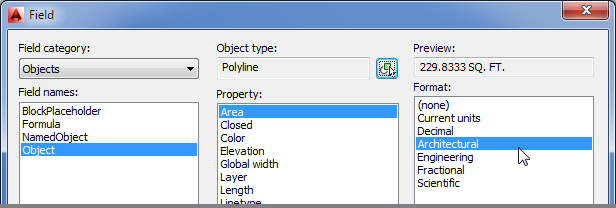
Next, you’ll alter the rectangle to see how it affects the field:
Figure 11-5 Expose the grips.

In previous exercises, you changed existing text into fields. You can create new fields in either the Text or the Mtext command by selecting Insert Field from the context menu whenever you’re typing the text content.
In this exercise, you used a rectangle, but you can use any closed polyline to create an area field.
We’ve touched on just two of the many possible uses for fields. You can associate other types of properties, including the current layer, the drawing name, linetypes, and more. You can include Diesel macros as part of fields. (You’ll learn about Diesel macros in Chapter 26, “Customizing Toolbars, Menus, Linetypes, and Hatch Patterns.”) Fields can also be used in the Table feature (described in the next section), which enables you to create tables and schedules quickly. Fields are used to coordinate sheet labels with reference symbols in the AutoCAD Sheet Set feature described in Chapter 28, “Keeping a Project Organized with Sheet Sets.”
For most of your projects, the standard text objects will work just fine, but you may find fields useful when you know a label has to be associated with specific types of data in your drawing. In later chapters, you’ll have more opportunities to work with fields.
Adding Tables to Your Drawing
One of the most common text-related tasks you’ll do for your drawings is create schedules, such as door and window schedules or parts schedules. Such schedules are tables used to provide detailed information about the elements in your design.
In the past, AutoCAD users used Mtext or Text to create the content of schedules and then used line-drawing tools to create the cells of the schedule. Since AutoCAD 2006, you have been able to use tables to help you generate schedules more quickly. Tables allow you to format the columns and rows of text automatically, similar to formatting in spreadsheet programs.
Creating a Table
The first step in creating a table is to determine the number of rows and columns you want. Don’t worry if you aren’t certain of the exact number of rows and columns; you can add or subtract them at any time. In this exercise, you’ll create a table that contains 12 rows and 9 columns, as shown in Figure 11-6.
Figure 11-6 A sample table created with the Table tool
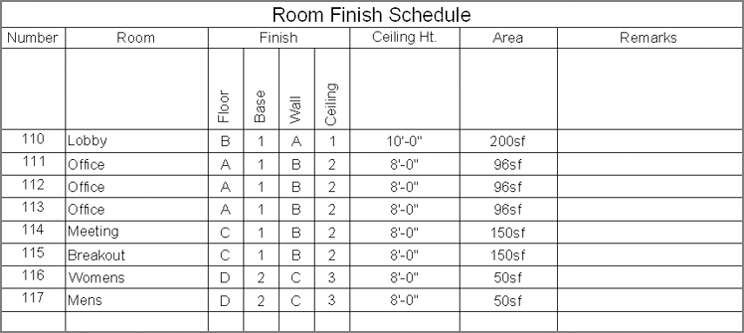
Start by creating the basic table layout:
Figure 11-7 The Insert Table dialog box
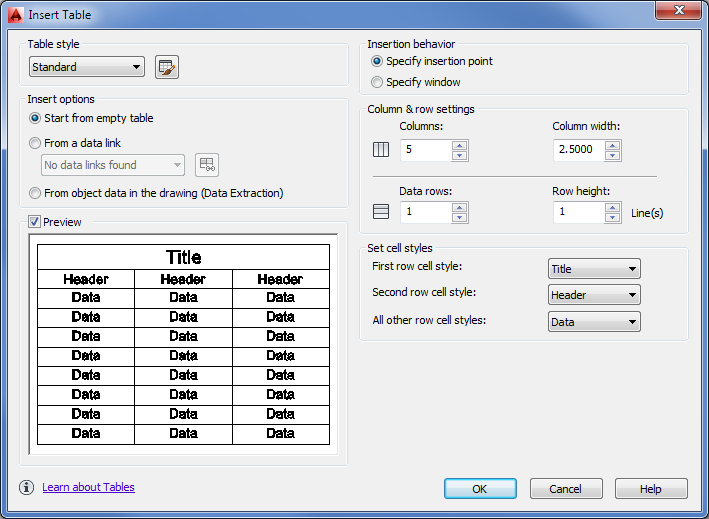
Adding Cell Text
You’ve just created a table and added a title. Notice that the table actually contains 14 rows, including the title row at the top and an additional row for the headings of each column. You can delete these additional rows if you don’t need them, but for now you’ll start to add some text to the table:
Figure 11-8 Double-click the first cell shown here.
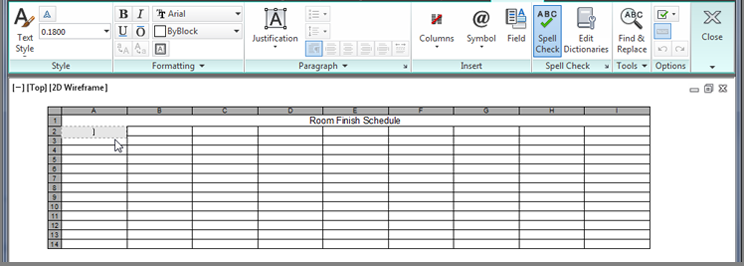
You have the column headings in place. Now you need to do a little extra formatting. In step 5, you left three cells blank because four of the columns will be combined under one heading: the Finish heading covers the Floor, Base, Wall, and Ceiling columns. Next, you’ll combine the blank cells with the Finish heading:
Figure 11-9 Select a group of four cells.

Now you need to add the subheads under the Finish header:
Figure 11-10 Double-click this cell and the Text Editor tab appears.
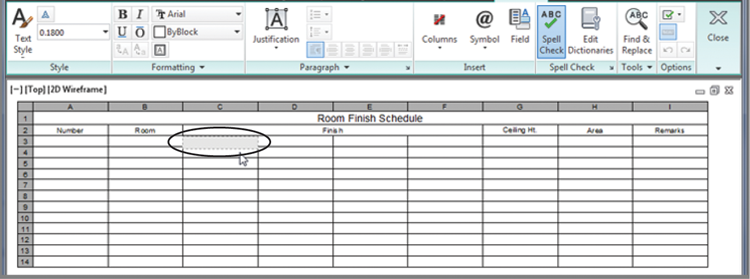
Figure 11-11 The table so far

Adjusting Table Text Orientation and Location
You now have the basic layout of the table, with one difference: The Floor, Base, Wall, and Ceiling labels you just added are oriented horizontally, but you want them oriented vertically, as shown in Figure 11-6. The following steps will show you how to rotate a set of labels in a table so they appear in the orientation you want:

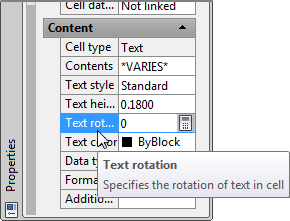


In the previous exercise, you learned how you could adjust the text orientation through the Properties palette. You can also adjust the width of cells through the Properties palette. Or if you prefer, you can adjust the width of multiple cells by adjusting the grip location of selected cells.
Now continue to add text to the cells and adjust their sizes:
Figure 11-12 The table with the columns resized
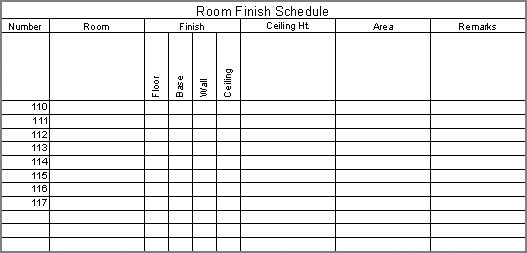
Now, suppose you want to delete one of the extra rows of cells at the bottom of the table or add a new row. Here’s how:
You may notice the Delete Columns and Insert Columns options in the context menu that let you add or delete columns. These options function in a way that’s similar to how the Delete Rows and Insert Rows options function. You can also use the tools in the Rows and Columns panels of the contextual Table Cell tab to insert and delete rows and columns.
Editing the Table Line Work
So far, you’ve concentrated on how you can format text and cells in a table, but you’ll also want some control over the lines in the table. Typically, heavier lines are used around the border of the table and between the title and the rest of the table.
Selecting a cell, right-clicking, and selecting Borders from the context menu option lets you modify the outline of the border. When you select this option, the Cell Border Properties dialog box opens (see Figure 11-13).
Figure 11-13 Setting border properties
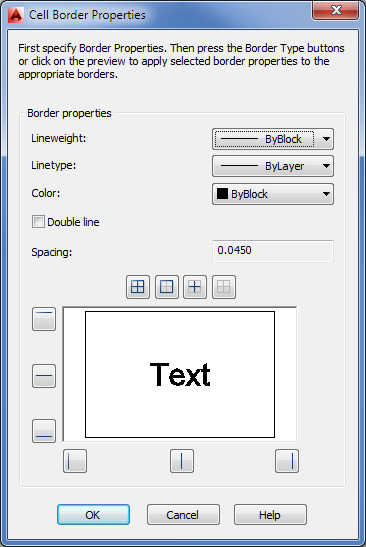
You can use this dialog box to fine-tune the appearance of the line work of the table. Try the following exercise to see firsthand how this dialog box works:
Figure 11-14 Click to display outside borders.
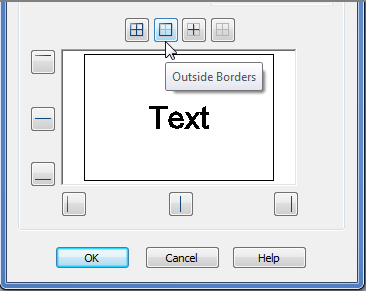
You can also adjust the lineweights of the borders that encircle a group of cells, as demonstrated in the following exercise:
Figure 11-15 The borders updated
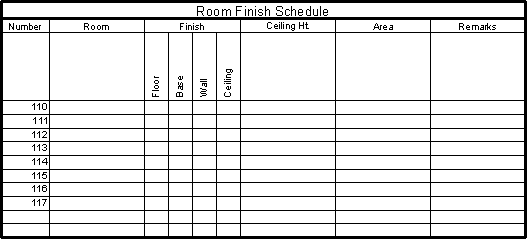
The Cell Border Properties dialog box also lets you set the line colors by selecting a color from the Color drop-down list before selecting an Apply To option. In addition, there are several other buttons around the preview panel (see Figure 11-16) that let you select the lines that are affected by the Cell Border Properties settings.
Figure 11-16 Setting which borders will be affected
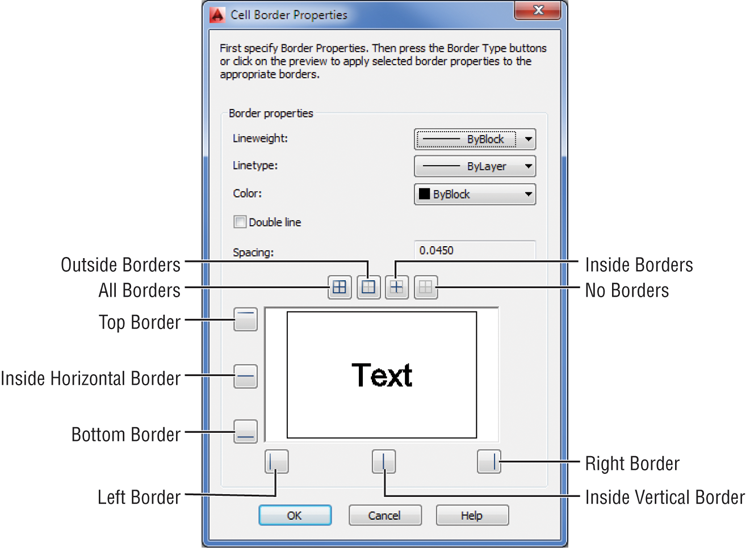
You can also use the preview panel to select individual borders by clicking the sample border in the preview panel. The sample changes to show you which border lines are affected.
Adding Formulas to Cells
In the beginning of this chapter, we mentioned that you can include formulas in cells of AutoCAD tables. This can be a great time-saver because you can set up a table with quantities that automatically adjust to changes in values in individual cells. You don’t have to calculate the changes manually.
You may recall that formulas are a type of field and that a field can be linked with objects in a drawing so that the field displays the linked object’s properties. The formula field can be linked to several numeric text values.
Although fields are the tools you use for formulas, you don’t have to choose deliberately to add a field to a cell every time you want to add a formula. The exercise in the following section will demonstrate how you can add a formula by typing directly in a cell. AutoCAD takes care of converting your input into a field.
Using Formulas Directly in Cells
The simplest way to add a formula to a cell is to double-click the cell and then, when the Text Editor tab appears in the Ribbon, enter the formula directly in the cell with the addition of an = (equal sign) at the beginning. Try the following exercise to see how it works:
Figure 11-17 Selecting the cell for your formula

Figure 11-18 The cell with the sum of two other cells

In step 3, the equal sign tells AutoCAD to convert the text into a formula field. You may have noticed that when you start to edit a cell in a table, the row and column labels appear along the top and left side of the table. You can use these labels to determine the cell addresses for your formula.
In typical spreadsheet fashion, you can change the formula in a cell at any time. Double-click the cell containing the formula, and then edit the formula values and operators.
You can also use the Formula drop-down list from the Table Cell tab’s Insert panel to select from a set of predefined math operations (see Figure 11-19).
Figure 11-19 The Formula drop-down list in the Insert panel
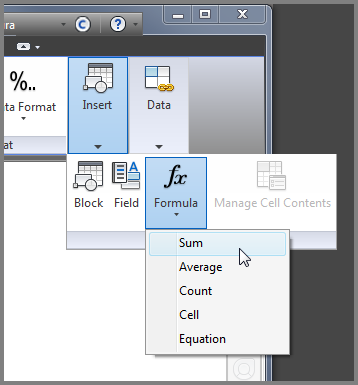
Click in the cell where you want to place the formula; then, in the Table Cell tab, click the Formula drop-down list in the Insert panel and select the operation you want to use. Next, place a selection window around the cells you want to include in the formula. Click in the first cell that you want to include in the formula, and then click in the second cell. As you do this, a selection window appears. All the cells that are included in the selection window are included in the formula.
Using Other Math Operations
In the previous exercise, you used the plus sign to add the value of two cells. You can string together several cells’ addresses to add multiple cells, as follows:
=A2+A3+A4...You can also subtract, multiply, or divide by using the – (subtract or minus), * (multiply or asterisk), or / (divide) signs. To perform multiple operations on several cells, you can group operations within parentheses in a way similar to how you would in a typical spreadsheet formula. For example, if you want to add two cells together and then multiply their sum by another cell, use the following format:
=(A2+A3)*A4The Average, Sum, and Count buttons that appear in the Formula flyout on the Table Cell tab’s Insert panel give you quick access to these frequently used functions. You can add to a cell the average value of a set of cells, the sum of a set of cells, or the count of the number of cells. When you click one of these options after selecting a cell, you’re prompted to select several cells with a selection window. Once you’ve selected a set of cells, you see the appropriate formula in the currently selected cell. Clicking the Average button, for example, produces a formula similar to the following:
=Average(A1:B5)Clicking the Sum button produces a formula like the following:
=Sum(A1:B5)In both cases, a range of cells is indicated by a colon, as in A1:B5. You can use this format when entering formulas manually. You can also include a single cell with a range by using a comma:
=Sum(A1:B5,C6)Importing and Exporting Tables
Data of the kind found in tables is often shared with others who may not be AutoCAD users. For this reason, you’ll want to be able to move table data to and from your drawing to other applications so that it can be viewed and edited by others. AutoCAD offers the following methods for importing and exporting tables.
Importing a Table
Frequently, tables are created outside AutoCAD in a spreadsheet program such as Microsoft Excel. You can import an Excel worksheet as an AutoCAD table by using the AutoCAD Entities option in the Paste Special feature. The ability to import tables lets non-AutoCAD users create the table data while you concentrate on the drawing.
Try the following exercise to see how you can import a table from a worksheet:
Figure 11-20 Selecting the door data in the 11a-plan.xls spreadsheet
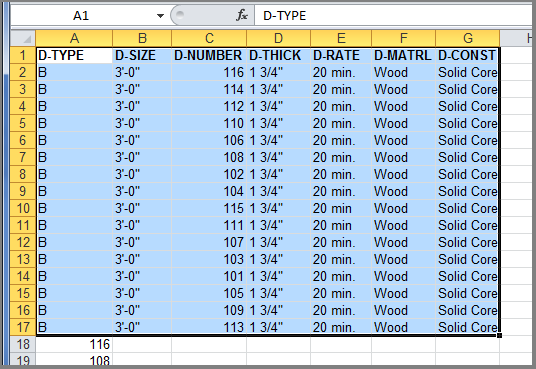
Figure 11-21 The Paste flyout
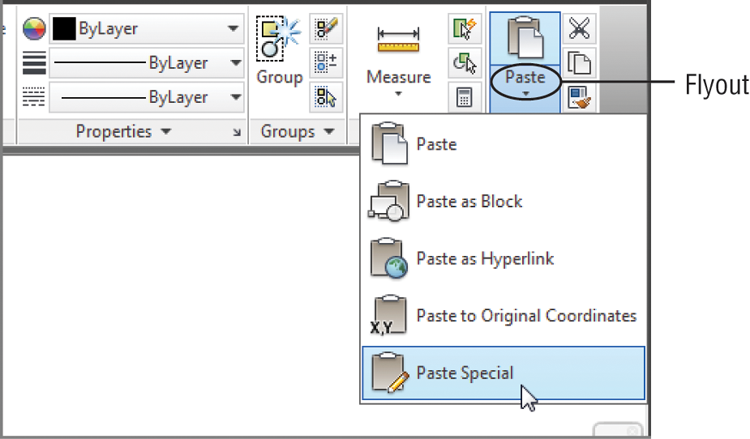
In this exercise, you imported the worksheet by using the default standard table style. This gives you a simple-looking table using the AutoCAD Txt font. You can set up a custom table style, as described later in this chapter, with the fonts and borders you want and then import the table for a more customized appearance. Make sure your custom table style is the current style before you import the worksheet.
Exporting Tables
You might want to export your AutoCAD table to a spreadsheet program or database. You can do this using a somewhat hidden option in a context menu. Follow these steps:
The file is saved with a .csv filename extension. This type of file is comma delimited and can be read by most spreadsheet programs, including Excel. Unfortunately, the CSV file doesn’t retain the AutoCAD table formatting.
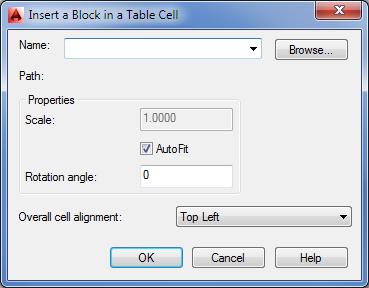
To open the exported file from Excel, choose File ⇒ Open in the Excel menu bar; then, in the Open dialog box, select Text Files (*.prn, *.txt, *.csv) in the Files Of Type drop-down list. You can then locate the exported table and open it.
Creating Table Styles
If you find that you’re creating the same table layout over and over, you can set up predefined table styles. You can set up the properties of the title, column headings, and data in advance so that you don’t have to set them up each time you create a table. For example, if you prefer to use Arial bold at 0.25″ for the title and standard Arial at 0.125″ for the column headings, you can create a table style with those settings. The next time you need to create a table, you can select your custom table style and specify the number of columns and rows; then you’ll be ready to add the data without having to format the text.
Adding or Modifying a Table Style
The method you use to create a table style in AutoCAD is similar to the method used to modify an existing one.
To create a table style, follow these steps:
Figure 11-22 The Table Style dialog box
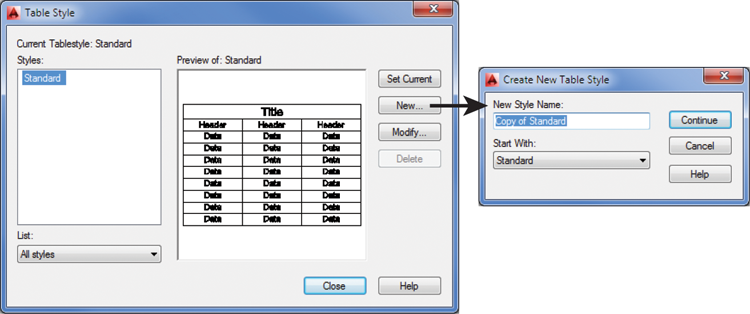
Figure 11-23 The New Table Style dialog box
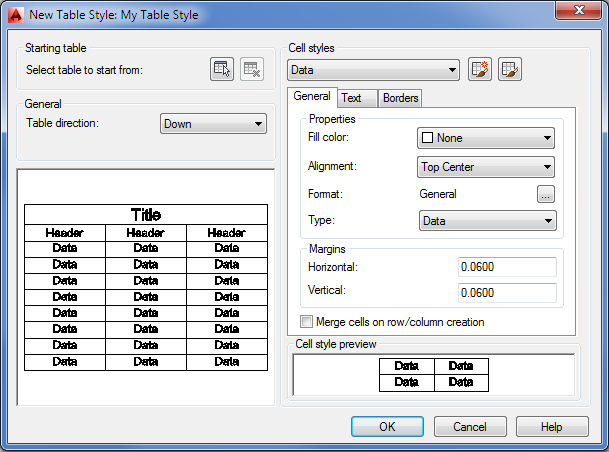
After you’ve created a style, you can select it from the Table Style group of the Insert Table dialog box that you used to create the sample table (see Figure 11-24). To open the Insert Table dialog box, click Table in the Home tab’s Annotation panel.
Figure 11-24 Select the table style in the Insert Table dialog box.

You can also open the New Table Style dialog box by clicking the Launch The Table Style Dialog button just to the right of the Table Style drop-down list in the Insert Table dialog box.
The Table Style Options
Let’s take a closer look at the New Table Style dialog box, shown earlier in Figure 11-23. It may seem a bit bewildering at first, but once you take the time to explore the parts of this dialog box, it’s fairly straightforward. The following offers a description of the parts of the New Table Style dialog box by group:
- General gives you control over the fill color, alignment, format, and type of information presented in the cell. The Margins options control the margins in the cell. The Merge Cells On Row/Column Creation option at the bottom of the General tab causes the cells to merge into a single cell for the selected cell style.
- Text gives you control over the default text style, the height and color, and the angle of the text in the cell.
- Borders lets you control the lineweight for the borders of the cell.
